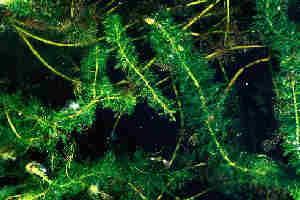Home
> Eurasian Water Milfoil Background Information
Eurasian Water Milfoil Background Information
What is Eurasian Water Milfoil (Myriophyllum spicatum L.)? EWM is an "evergreen" perennial aquatic plant that grows submersed in water as deep as light will penetrate. In our clear waters, it grows faster and at greater depths. The only part of the plant that grows out of the water is the short flower stalk late in the summer. The submersed shoots form a dense offensive canopy at the water's surface. In the winter, green stems may be found under the ice, although with little metabolic activity. EWM was first reported in the United States in the 1940's in Chesapeake Bay and spread rapidly. The current EWM distribution includes 45 of the 50 states and three Canadian providences. EWM is possibly the most widespread nonnative aquatic plant in North America.
What does EWM look like? EWM has the following recognizable characteristics: - Delicate feather-like leaves. Leaflets are mostly the same length.
- Leaves are usually limp when out of the water.
- Leaves arranged in whorls (circles) of three to five around the stem.
- Usually twelve to twenty-one leaflet pairs per leaf.
- Long spaghetti-like stems.
- Stems and top "buds" are often reddish in color.
EWM should not be confused with Northern water milfoil, Coontail, Common Bladderwort or Elodea which are common to our area. Northern water milfoil is the most confused and its features include: - Rigid feather-like leaves forming a Christmas tree shape. Lower leaflets are long.
- Leaves usually stiff when out of the water.
- Leaves arranged in whorls (circles) of four to six around the stem.
- Usually seven to ten leaflet pairs per leaf.
- Stem is usually whitish or whitish green in color.
How does EWM spread? EWM is prolific but does not spread well by seeds. It primarily spreads by fragments commonly transported by boats and trailers that form roots and develop new plants. These plants grow rapidly, out performing other aquatic plants. These new plants send out shoots and runners that creep along beds of lakes and rivers to form new colonies. These colonies soon out compete other aquatic plants. A small piece can multiply into hundreds of plants in one year!
What are the problems with EWM? Here are some of the detrimental effects of EWM: - The colonies quickly make an unsightly heavy mat just below the water surface.
- Swimming is dangerous and watercraft have difficulty maneuvering through the thick mat of vegetation.
- Crowds out and overtakes native plants.
- Degrades water quality through eutrophication.
- Obstructs the swimming space of fish and fences out larger predatory fish.
- Shelters too many juvenile fish causing stunted growth and a higher potential for disease.
- Creates food shortages for fishes by reducing the diversity of invertebrates.
- Can cause fish kills by depleting dissolved oxygen when shoots decay in autumn.
What can be done? Every Barnes resident can help reduce the spread of EWM! - Inspect and remove any visible mud, plants, fish or animals before transporting boat/trailer. Place material well into wooded area.
- Drain water from equipment (boat, motor, trailer, live wells) before transporting.
- Dispose of unwanted live bait in the trash.
- Do not drive boats through or near suspected plant beds.
- Volunteer to help monitor boat landings.
- Report any suspected plant to DNR or John Kudlas, Barnes EWM Coordinator.
Wisconsin laws prohibit launching a boat or placing a trailer or boat equipment in navigable waters if it has aquatic plants or zebra mussels attached.
|
|
|
|
|
The notices, agendas, minutes and postings on the Town website are for informational purposes only.
They may not be the most current version and therefore are NOT considered the official or legal copy.
|
CONTACT THE TOWN
715-795-2782
Mon., Tues., Thurs., Fri. 8:00 AM - 4:00 PM & Wed. 8:00 AM - 12:00 PM
[email protected]
3360 County Highway N, Barnes, WI 54873
|
|


